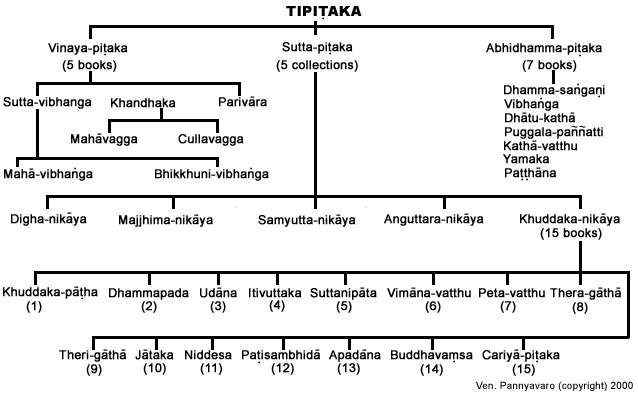
Editor’s note: This feature was first published in the now-retired Bodhi Journal, Issue 6, December 2007.
Although the Dhamma[1] Theory is an Abhidhammic innovation, the antecedent trends that led to its formulation and its basic ingredients can be traced to the early Buddhist scriptures which seek to analyse empirical individuality and its relation to the external world. In the discourses of the Buddha, there are five such modes of Analysis. The first, the analysis into N?ma and R?pa[2], is the most elementary in the sense that it specifies the two main components the mental and corporeal aspects, of the empirical individual. The second is that into the Five Khandhas (aggregates): corporeality (R?pa), sensation (Vedan?), Perception (Saññ?), mental formations (Sa?kh?r?), and consciousness (Viññ???a)[3]. The third is that into six Dh?tus (Elements): Earth (Pa?hav?), Water (?po),Temperature (Tejo), Air (V?yo), space (?k?sa), and Consciousness (Viññ??a)[4]. the fourth is that into twelve ?yatanas (avenues of sense-perception and mental cognition): the eye, ear, nose, tongue, body and mind; and their corresponding objects: visible form, sound, smell, taste, touch, and mental objects.[5] The fifth is that into eighteen Dh?tus (Elements)[6] , an elaboration of the immediately preceding mode obtained by the addition of the six kinds of consciousness which arise from the contact between the sense organs and their objects. The six additional items are the visual, auditory, olfactory, gustatory, tactile, and mental consciousness.
Now the purposes of which Buddhism resorts to these analysis are varied. For instance, the main purpose of the Khandha-analysis is to show that there is no ego either inside or outside the five Khandhas which go to make up the so called empiric individuality. None of the Khandhas belong to me (n’etat mama), they do not correspond to ’I’ (n’eso ‘ham asmi), nor are they myself (n’eso me atta).[7] Thus the main purpose of this analysis is to prevent the intrusion of the notions of ‘mine, ‘I’, and ‘my self’ into what is otherwise an impersonal and egoless congeries of mental and physical phenomena. on the other hand, the analysis into eighteen Dh?tus is often resorted to in order to show that consciousness is neither a soul nor an extension of a soul-substance but a mental phenomenon which comes into being as a result of certain conditions: There is no independent Consciousnesss which exists in its own right.[8] In similar fashion, each analysis is used to explain certain features of sentient existence. It is, in fact, with reference to these five kinds of analysis that Buddhism frames its fundamental doctrines. The very fact that there are at least find kinds of analysis shows that none of them can be taken as final or absolute. Each represents the world of experience in its totality, yet represents it from a pragmatic standpoint determined by the particular doctrine which it is intended to illuminate. The Abhidhammic Doctrine of Dhammas developed from an attempt to draw out the full implications of these five types of analysis. it will be seen that if each analysis is examined in relation to other four, it is found to be further analyzable. That the first, the analysis into N?ma and R?pa, is further analyzable is seen by the second, the analysis into the five Khandhas. For the second, the N?ma-component of the first is analysed into sensation, perceptions, mental formations, and consciousness. That the analysis into Khandhas, too,can be further analysed as shown not only by the Khandha, which means ‘group’, but also by the next analysis, that into six Dh?tus. For in the latter, the R?pa-component of the former is analysed into four, namely, earth, water, temperature, and air. That the analysis into six Dh?tus, is also further analyzable is seen from the fact that consciousness,which is reckoned here as one item, is made into four in the Khandha-analysis. That the same situation is true of the analysis into twelve ?yatanas is shown by the next analsyis, that into eighteen Dh?tus, because the latter is an elaboration of the former. This leaves us with the last, the Dh?tu-analysis with eighteen items. can this considered final? This susposition too must be rejected, because although consciousness is itemized as six-fold, its invariable concomitants such as Sensation (Vedan?) and Perception (Saññ?) are not separately mentioned. It will thus be seen that none of the five analysis can be considered exhaustive. In each case, one or more items is further analyzable.

This, it seems to me, is the line of thought that led the ?bhidhammikas to evolve still another mode of analysis which in their view is not amenable to further analysis. This new development, which is more or less common to all the systems of Abhidhamma, is the analysis of the world of experience into what came to be known as dharmas (Skt.) or dhammas (P?li). The term dhamma, of course looms large in the discourses of the Buddha, found in a variety of senses which have to be determined by the specific context. In the Abhidhamma, however, the term assumes a more technical meaning, referring to those items that result when the process of analysis is taken to its ultimate limits. In the Theravada Abhidhamma, for instance, the aggregates of corporeality (of the Khandha-analysis) is broken into twenty-eight items called R?pa-dhammas. The next three aggregates –sensation, perception,and mental formations – are together arranged into fifty-two items called Cetasikas. The fifth Consciousness, is counted as one item with eighty-nine varieties and referred to as Citta.[9]
Thus the Dhamma-analysis is an addition to the previous five modes of analysis. Its scope is the same, the world of conscious experience, but its divisions are finer and more exhaustive. This situation in itself does not constitute a radical departure from the earlier tradition, for it does not as yet involve a view of existence that is at variance with that of early Buddhism. There is, however, this situation to be noted: Since the analysis into dhammas is the most exhaustive, the previous five modes of analysis become subsumed under it as five subordinate classification.
The definition and classification of these dhammas and explanation of their interconnections form the main subject matter of the canonical Abhidhamma. The ?bhidhammikas presuspose that t understand any given item properly is to know it in all its relations, under all aspects recognized in the doctrinal and practical discipline of Buddhism.Therefore, in the Abhidhammpi?aka, they have classified the same material in different ways and from different points of views.This explains why, in the Dhammasanga?? and other Abhidhamma treatises , one encounters innumerable lists of classifications. Although such lists may appear repetitive, even monotonous, they serve a useful purpose, bringing into relief, not only the individual characteristics of each dhamma, but also its relations to other dhammas.
With this aim in view, bringing out the nature of the dhammas, the Abhidhamma resorts to two complementary methods: that of analysis (bheda) and that of synthesis (sangaha).The analytical method dominates in the Dhammasanga??, which according to the tradition is the first book of the Abhidhammapit??aka; for here we find a complete catalogue of the dhammas, each with a laconic definition. The synthetical method is more characteristic of the Pa??h?na, the last book of the Abhidhammapi?aka; for here we find an exhaustive catalogue of the conditional relations of the dhammas.The combined use of these two methods shows that according to the methodological apparatus employed in the Abhidhamma, “a complete description of a thing requires, besides its analysis, also a statement of its relations to certain other things.”[10] Thus if analysis plays an important role in the Abhdhamma’s methodology, no less important a role is played by synthesis. Analysis that the world of experience is resolved into a plurality of factors; synthesis shows that these factors are not discrete entities existing in themselves but inter-connected and inter-dependent nodes in a complex web of relationships. It is only for the purpose of definition and description that things are artificially dissected. In actuality, the world given to experience is a vast network of tightly interwoven relations.
The Abhidhammic doctrine of dhammas has sometimes been represented as a radical pluralism. Such an interpretation is certainly not admissible. It is mostly Stcherbatsky’s writings,[11] mainly based on the Sarv?stiv?da sources, hat has given currency to this incorrect interpretation. “Up to the present time,” observes Nyanaponika Thera, “It has been a regular occurrence in the history of physics, metaphysics, and psychology that when a whole has been successfully dissolved by analysis, the resultant parts come again to be regarded as little wholes.”[12] This is the kind of process that culminates in radical pluralism. As we shall soon see, about a hundred years after the formulation of the Dhamma Theory, such a trend surfaced within certain schools of Buddhist thought culminated in the view that the dhammas exist in all three periods of time. But the P?li Abhidhammapitaka did not succumb to this error of conceiving the dhammas as the ultimate unities or discrete entities. In the P?li tradition, it is only for the sake of definition and description that each dhamma is postulated as if it were a separate entity; but in reality it is by no means a solitary phenomenon having an existence of its own. This is precisely why the mental and material dhammas are often presented in inter-connected groups. In presenting them thus the danger inherent in narrowly analytical methods has been avoided – the danger, namely, of elevating the factors resulting from analysis to the status of genuinely separate entities. Thus if analysis shows that composite things cannot be considered as ultimate unities, synthesis shows that factors into which the apparently composite things are analysed (ghana-vinibbhoga) are not discrete entities.[13] .
If this Abhidhammic view of existence, as seen from its doctrine of dhammas, cannot be interpreted as radical pluralism, neither can it be interpreted as an out-and-out monism. For what are called dhammas – the component factors of the universe , both within us and outside is – are not fractions of an absolute unity but a multiplicity of co-ordinate factors. They are not reducible to nor do they emerge from, a single unity, the fundamental postulate of monistic metaphysics. If they are to be interpreted as phenomena, this should be done with the proviso that they are phenomena with no corresponding noumena, no hidden underlying ground. For they are not manifestations of some mysterious metaphysical substratum, but processes taking place due to the interplay of a multitude of conditions.
In thus evolving a view of existence which cannot be interpreted in either monistic or pluralistic terms, the Abhidhamma accords with the ‘middle doctrine’ of early Buddhism. This doctrine avoids both the eternalist view of existence which maintains that everything exists absolutely (Sabba? atthi [14] and the opposite nihilistic view of existence which maintains that absolutely nothing exists (sabba? n’atthi). [15] It also avoids, on the one hand, the mononistic view that everything is reducible to a common ground, some sort of self-substance (sabba? ekatta?)[16] , and on the other, the opposite pluralistic view that the whole of existence is resolvable into a concatenation of discrete entities (sabba? puthuta?).[17] Transcending these two pairs of extreme views, the middle doctrine explains that phenomena arise in dependence on other phenomena without a self-subsisting noumenon which serves as the ground of their being.
The inter-connection and inter-dependence of these dhammas are not explained on the basis of the dichotomy between substance and quality. Consequently, a given dhamma does not inhere in another as its quality, nor does it serve another as its substance. The so called substance is only a product of our imagination. The distinction between substance and quality is denied because such a distinction leaves the door open for the instruction of the doctrine of a substantial self (attav?da) with all that it entails. Hence, it is with reference to causes and conditions that the inter-connection of the dhammas should be understood. The conditions are not different from the dhammas, for it is the dhammas themselves that constitute the conditions. How each dhamma serves as a condition (paccaya) for the origination of another (paccayuppanna) is explained on the basis of the system of conditioned genesis (paccayak?ra-naya).[18] This system, which consists of twenty-four conditions aims at demonstrating the inter-dependence and dependent co-origination (pa?iccasamupp?da) of all dhammas in respect of both their temporal sequence and their spatial concomitance.
Endnotes:
1. The term ‘Dhamma’ denotes not only the ultimate data of empirical existence but also the unconditional state of Nibb?na. In this study, however, only the former aspect is taken into consideration.
2. The reference here is to its general sense. in its special sense, ‘N?mar?pa’ means the following pscho-physical aspects: “Sensation, perception, will, contact, and attention. This is called N?ma.The four material elements and the form depending on them. This is called ‘R?pa’ (S.II.3). In the oft-recurrent statement, villanapaccaya n?mar?pa?, the reference is to the special sense.
3. See e.g S.III.47, 86-87;M.III.16
4. See e.g S.II.248;III.231
5. See e.g D.II.302;III.102, 243; A.III.400;V.52
6. See e.g S.II.140; D.I.79;II.38; A.I.255; III.17
7. S.III.49
8. Cf. Allatra paccaya natthi villanassa sambhavo (M.III.281)
9. See Dhs.5ff.
10. Nyanaponika Thera, Abhidhamma Studies (Kandy, 1976,1976), p.21
11. Cf. The Central Conception of Buddhism (London,1923); Buddhist Logic (Reprint: New York), Vol. I, Introduction.
12. Nyanaponika Thera, p.41
13. VsmM. 137
14. S.II.17,77
15. Ibid
16. S.II.77
17. Ibid.
18. For a short but lucid description, See Narada Thera, A Manual of Abhidhamma (Colombo,1957), Vol.II, pp.87ff






